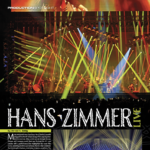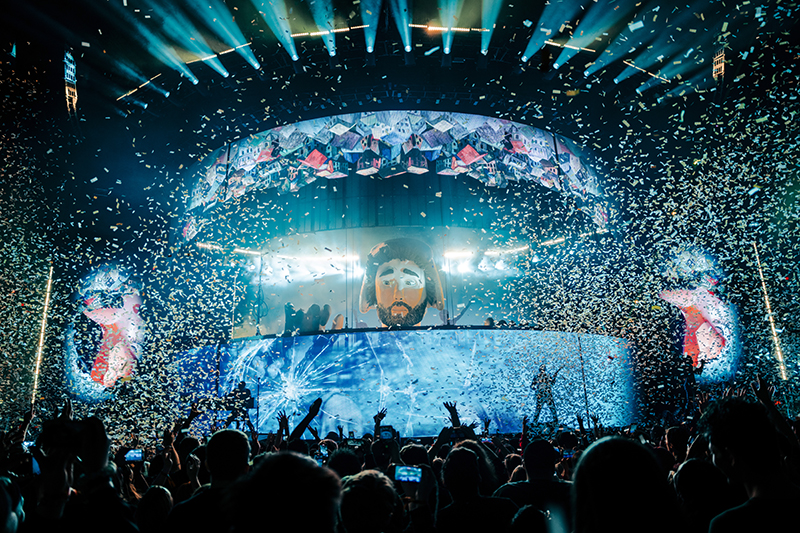
The American alt-pop trio AJR consists of three brothers, Adam, Jack, and Ryan Met. Their current tour—the band’s first arena tour—takes its name from the group’s fifth album, The Maybe Man. This tour provides audiences with an emotional journey—a tribute to the brothers’ late father who helped shape them. Longtime collaborators, Production Designer Mitchell Schellenger and Lighting Designer Ezra Donellan created a massive show complete with big, dynamic lighting looks, immersive video elements, and dynamic staging to support the group’s storytelling for its legions of fans. Schellenger and Donellan spoke with PLSN as we shine a spotlight on this production.
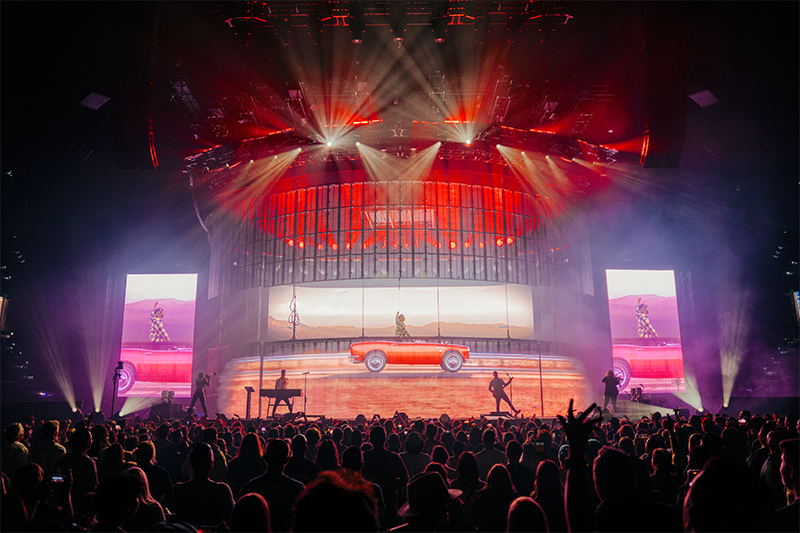
Talk about the design aesthetic you wanted for the tour and how it supports AJR.
The kind of show that the band wants to accomplish is a cross between a big crazy show, mixed with a lot of beautiful theatrical elements. So, it’s about toeing the line between these big crazy moments where they want a lot of energy, a lot of movement, they want people in the crowd to lose their minds a little. Then juxtaposed with these complex theatrical moments that require really hairpin trigger moments that need to be very specifically lit, very specifically done, which require a lot of attention and updating every single day.
Does the band have a lot of input into the design?
The band is incredibly involved, from the beginning to the end process as far as the design goes. They have very specific ideas about what they want to accomplish, and my and Mitchell’s job becomes figuring out how to accomplish that and what the best approach is going to be to bring their vision to life. Along the way, also giving them input of our own. They’re very receptive to receiving input. Then it goes from them conceptually to a collaboration of what’s the best way to make this work. How are we going to make it look the best? Between Mitchell, the band, and myself, the end product is a result of that collaborative process.
Is there a lighting solution, a cue, or a sequence that you’re particularly pleased with?
The band loves to see movement on stage; lights moving around and creating these big energy moments. But for me, some of the moments in the show that I’m most proud of are those smaller static moments that still manage to look big and beautiful. I would say the song “Touchy Feely Fool” is a good example of that, where there aren’t necessarily a lot of lights moving around. But because of the lighting rig itself, and the fixtures that we chose—the [Robe] TetraXs—I had access to all their pixel features that do a nice job. I was able to really take all the accents of the music and create a really beautiful scene. That’s what the song is overall. It’s this spaceship, created with content and lots of little things that accent that look like buttons in a spaceship. I really love that moment in the show. After that, I would say “The DJ Is Crying for Help,” which is just a big, dark, mysterious look. Again, I unlocked everything that the TetraXs can do—panning, tilting, a lot of beautiful chases. The TetraX was the workhorse pixel fixture that can pretty much do all the fun little things I need them to do for the show. I really love those two moments in the show.
What are you using for your key lighting and remote followspots?
The profile fixture I’m using for the whole rig is the Robe FORTE, which is also being used for key lights as well through the [Robe] RoboSpot system. As far as key lighting is concerned, what was important was that I wanted to keep it consistent with the rest of the rig. I like having a key light that can do what the rest of my rig can do, because there are moments in the show where I’d like it to be more than just being a key light sometimes, and I want it to be consistent across the board. There’s no shame in having a bunch of different fixtures, but for my personal preference, I like to try to limit it to only a few different types of fixtures. I think it’s a lot cleaner to keep that all consistent across the board, to just create a cleaner and more consistent look for the entire show as a whole.
I really enjoy the RoboSpot system, especially on a show like this. The band has a lot of input on key lights and those key lights go on and off at very specific times. So, for example, in any given song, those key lights will come on and off on the band upwards of 10 to 20 times sometimes. And on a dime; they love snap blackouts. It’s very much the essence of a theatrical show. And for choruses to be big, dark, and mysterious and then to snap the keys back on. So, we’re constantly using the RoboSpot system. We also have a lead singer that is constantly moving. The benefit of having the RoboSpot system is that one of the spot ops always stays with one person. That way no matter what we’re doing, no matter how many times we’re coming on, off, changing the light source itself, we know that our principals are always covered and there is always going to be something on them—at any given time.
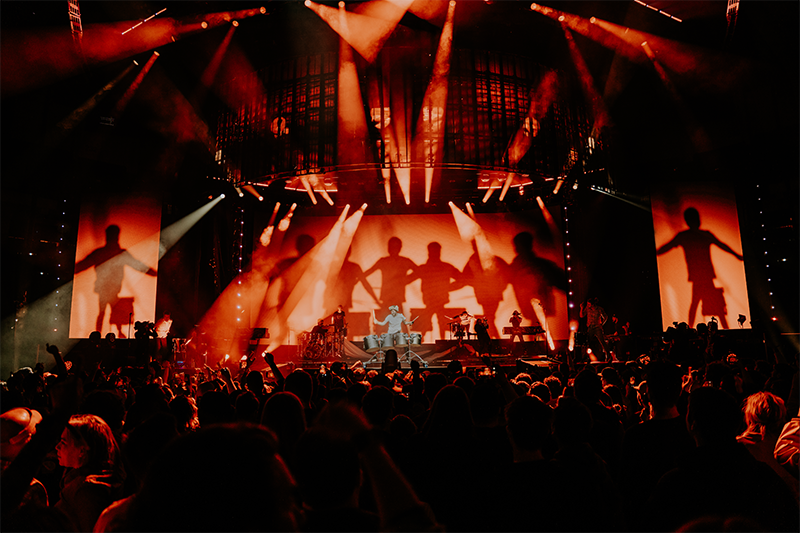
Talk about layering lighting and video together for this tour.
As we’ve gotten bigger, the content has become so much more involved and so much bigger. From the beginning of the process of conceptualization into rehearsal, I’m constantly being updated and involved in what the content looks like because it plays so closely with what lighting is doing. There’s nothing more that I enjoy than when you have a beautiful piece of content, and the lighting really matches what’s going on. Making the entire thing just one cohesive, big, beautiful look. There are a lot of content moments in this show where I’ve looked at the content and made sure that even in little intricate moments, the lights are playing along with the content.
We had a moment in rehearsal where we didn’t have content for a song. Mitchell had them build the content based on what my lighting was doing, which was really cool because now the content is doing what the lighting’s doing. I will say, it can be a challenge. We have two shows worth of video product on this show, so that’s why having the fixtures I have are important too. Just overcoming the sheer brightness of the LED screens sometimes can be a challenge. Making sure that my positions, and what I’m doing with the lights are not getting drowned out by the large amount of video, but I think it’s something that we really do a good job toeing the line between the two.
How has lighting vendor Gateway Studios & Production Services’ support been for the tour?
We’ve long had a relationship with David Haskell going back to his days at Morris, when they supported the tour. He’s always been a big supporter of us in general, and a good resource to talk to. As far as Gateway as a company, we hadn’t worked with them before, but they were very accommodating to just what our needs were for the show. I am a big supporter of Robe products; I use them in all my shows and Gateway had access to those products and were able to accommodate every fixture that we needed without any substitutions or issues. They really were the right choice, and they were fantastic on this tour.
What’s something that you would call out to another designer about the design for this tour?
The end of the show, I think, is very powerful. The end of the show crescendos into a big speech about the process of what the last year was for the band. It’s quite emotional and really heartfelt. We have this giant puppet—that was the band’s idea from the beginning of this process. It’s a big, beautiful, powerful moment when you look at the speech, right before the finale, to the reveal of the giant puppet head, which is a massive practical effect. That’s another thing that I really like about these guys. As much as they use content, there are a lot of practical effects in the show, and I am a sucker for practical effects. I think that those are cool moments.
Any final thoughts?
Every day, I’m just grateful that I got the opportunity to do this honestly, and that I get to do it with these guys. Getting to do bigger and bigger venues together, just to be able to grow with them, it has been a wonderful, beautiful adventure. It’s not lost on me sometimes when I’m at front of house, the things that I’ve learned are just so awesome; I’m just grateful to be a part of it.
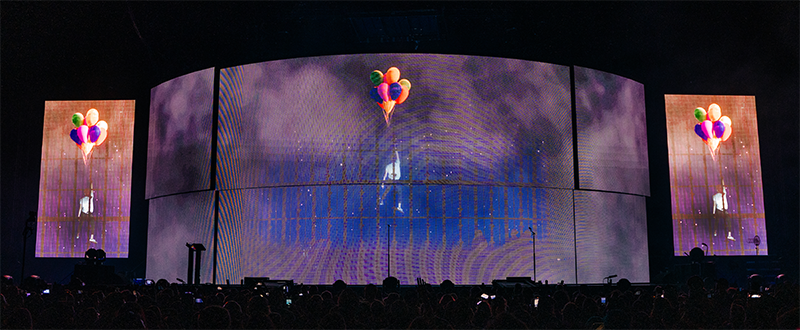
What was your design aesthetic for the tour and how does it support AJR?
AJR is a unique band. They’re all about creating a unique concert experience that doesn’t really conform to the traditional mold of a regular rock show. They love the gags, they love the tricks, they want to do something unique and cool, and most of that truly does stem from the band themselves. They’re very, very involved in the storyline of the show. They’re very involved in screen content creation, set design choices, the quirky gags that we do in the show, it all truly stems from them. I like to say I’m almost the Creative Translator for them more than the Creative Director. The bulk of my job is taking what’s in their head and converting that into something tangible that we can then do logistically on tour.
With this one, there was an underlying story of the band and losing their father. Really just trying to be the biggest versions of themselves, which a lot of the pieces of the show lead up to a moment at the very end where there’s literally a version of the singer that’s gigantic. It’s a huge custom-built puppet head, basically blinking and turning, and it has huge hands. So, that underlying storyline of being the biggest version of yourself dictated a lot of the decisions throughout the show. Ultimately, we all want it to be something fun on stage. We want the audience to always have something unique to see.
Every tour I’ve done with AJR, we’ve had a treadmill involved in some capacity. We have screen content that rolls past as he’s walking. We took that a step further with this show where we have a second treadmill that takes him up to another story basically, and it looks like he’s walking on top of rooftops. So, just fun, unique things like that throughout the show. There’s flying involved at one point. There’s a whole song where it looks like the singer is basically falling from space and the moment before he hits earth is when the blackout occurs at the end of the song. So, lots of clever things like that throughout the show.
Tell us about the two video screens and how they work together.
It’s all ROE product. It is Vanish V8T, the touring version with 50% transparency for the downstage curved screen. It’s six individually automated sections that nest upon themselves. So, when it’s in its full, open position, there are two eyebrows that are in front of each other. We can extend all that out and bring it down to be one big, closed configuration. We have the ability to bring down the side sections on their own and we do some masking components where we frame the stage. Then for the upstage screen, it’s all ROE CB5. Those are the two main video components. The I-Mag screens are also CB5, so everything upstage is CB5, everything downstage is Vanish V8T.
The screen arrangement allows us to close the screens and do some 3D effects during the intro. We walk through these different settings, foreshadowing the show a little bit. There’s one bit that’s quite funny. There’s a girl at a party and she’s on the upstage screen. Then she appears to become ill and she vomits, which ‘hits’ the downstage screen. So, I can certainly say I’ve never done 3D vomit in a show before, but for an AJR show, it gets a pretty good reaction out of the crowd. So, we do a lot of clever things like that with 3D video effects.
You also do some projection work in addition to the two video screens. Talk about that aspect.
It’s a complicated projection show. It has to be perfect every night, which is obviously a big ask on a touring show. The level of precision of the show overall is pretty tight. There’s a lot of trusses that have to land in a very specific spot, otherwise it’ll slightly throw things off. From a scale standpoint, it’s nothing too crazy. It’s 11 trucks, just over 90 rigging points. A relatively normal-sized arena show in A markets, but the crew has to be pretty precise and they’re all doing a really great job of getting that show in the building perfectly every night.
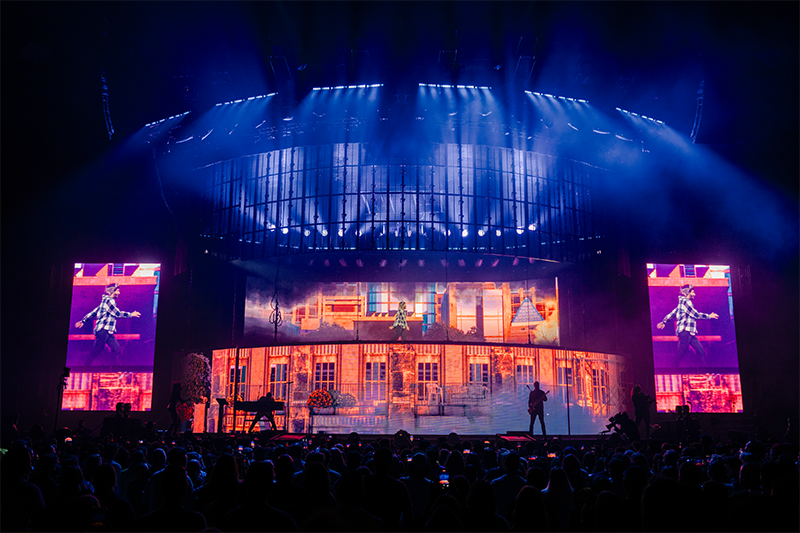
How did you address I-Mag and what were some of your other video gear choices for the tour?
We did integrate I-Mag for the first time with AJR. This is also their first tour with a camera package, video director, and video engineering on the road. That’s added a fun new element for them. We are using Notch as well, subtly, but still there to dress up the I-Mag looks. Even though we have two left and right screens that we refer to as ‘I-Mag screens,’ we don’t limit ourselves to just those. In terms of I-Mag, sometimes we put it on the side screens, but there are times when we put it on the upstage CB5 screen, as well as on the downstage V8T screen. We wanted to treat the LED real estate as one cohesive canvas and put the I-Mag imagery where it made sense as opposed to just sticking I-Mag on the sides, so that we could kind of make it a little bit more interesting.
We’re driving the whole show with Disguise gx2c servers. My buddies over at Dark Matter came in to do the Disguise programming. For the camera package, I deferred to Gateway. They have a great brand new 4K camera system that we used on this tour.
Who created the video content for the tour?
Wearing my Creative Director hat, I facilitated all the content. A couple of pieces were done through Station Six, my company, and a couple pieces were done through a friend of mine, Evan Schneider. The bulk of the content was done by Lightborne out of Cincinnati. Lightborne has been involved with AJR since I’ve been working with them; after three tours, they know how to speak AJR. I worked with Ryan McAllister, their Creative Director and a new Producer, Austin Winters on the content.
You mentioned the treadmills. Talk about the performer lifts and automation.
The staging automation is all TAIT, who has worked with us on AJR since the very beginning of my time with them. We have a full TAIT touring rolling arena stage, and all the video screen automation is TAIT. It’s all being driven by Navigator. We have the TAIT T-Winch that we use for performer flying. That’s a standard TAIT performer fly winch that lives in a 10’ stick of Tyler GT Truss. We have a whole Kabuki system with two sets of Kabuki drops for the upstage and downstage projection. Then we have a single TAIT solenoid for a light falling gag that takes place in the show. It appears that a moving light is malfunctioning, the prop ‘light’ then falls dramatically to the stage. We’ve got two treadmills; three toaster lifts, which are technically TAIT Flaggapults because they’re variable speed toasters. We’ve got an integrated scissor lift built into the stage that lifts one of the treadmills. We’ve got a whole band riser package with fascia, and all the TAIT Nav hoists that are moving things.
How was the support of Gateway Studio & Production Services for the video on the tour?
Gateway was also the lighting supplier as well as video; it’s all Gateway, which was handy to have everything come from one vendor. It made the discussions a little easier, especially because we had quite a few changes. We really needed quite a bit of cross-communication between departments, especially lighting and video. I think having it all come from one place made that conversation easy. There’s such a team approach to these shows. Everyone was in the loop. Gateway has been great. Their gear is awesome; everything’s new and works well. Their staff is great, and all the vendor crew that Gateway provided were awesome people.
Is there anything else you’d like to mention about working with AJR on this tour?
They’re a great group of guys. They are, by far, the most creatively involved musical act I’ve ever worked with, and I think they challenged me to do the best work that I possibly can. I think it’s a pleasure having an artist so involved just because it shows how much they care and it’s cool to watch their creative wheels turn and to see them get excited about production more so than I would see a typical band get. Their excitement over specific content things or specific automation cues. Just the fact that they notice all that stuff is pretty cool.
The next leg of AJR’s The Maybe Man tour is heading back out to arenas starting June 25.
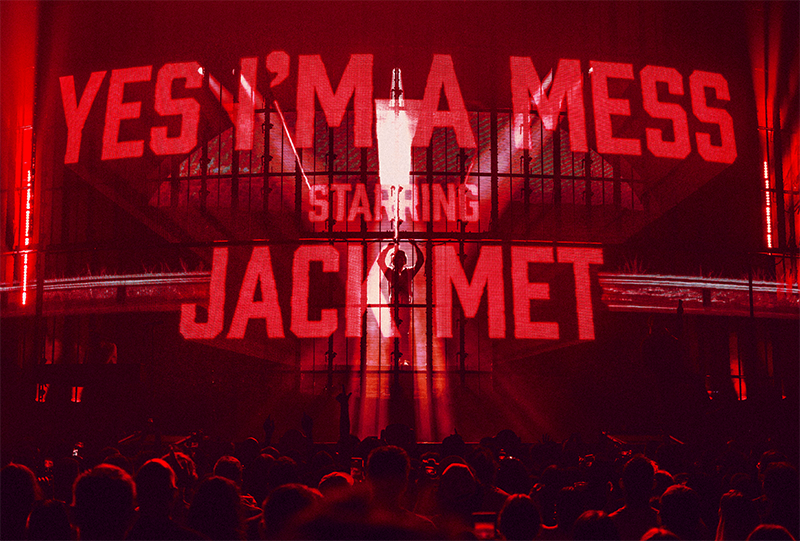
VENDOR VIEW
David Haskell, Account Executive; and Adam Ellis, Project Manager; Gateway Studios & Production Services (GSPS)
On the solutions GSPS provided for this tour:
Overall, this show is more of an “experience.” The integration of all design elements combined with the storytelling from the band’s music came together to create a 90-minute experience that is one of a kind. So, going into this project, it was clear that all elements of the show needed to be integrated to create a cohesive design. This meant working closely with both the Production Designer and Lighting Designer as well as TAIT for the production elements and automation elements to come together seamlessly and support the overall aesthetic of the show. Once the show begins, the design begins to tell a story using automated LED screens in conjunction with an expansive lighting rig.
To achieve the aesthetic the band and designers were looking for almost every square inch of space to be used above the stage. This created specific challenges moving from venue to venue in order to maximize safety without impacting the vision of the show. To allow for there to be enough clearance for the LED screens to travel during the show in their given configurations, we had to devise a super grid that would allow room for the automation motors as well as motors for scenic elements and lighting elements. This allowed the LED to fly in and out during the show without colliding, bringing the band’s vision to life without making any concessions to the technical elements of the show.
On working with Creative Director/Production Designer Mitchell Schellenger:
Mitchell is a very detailed type of designer and his creativity when designing the overall look of the show is always all encompassing from staging to product selection to content creation always results in a beautiful show. This show is similar in execution to a scripted Broadway show presented in a full-blown arena concert environment.
On supporting Lighting Designer Ezra Donellan:
It is always a pleasure working with Ezra. His design acumen along with his vision of what he wants to see is always concise. He has been with the band for several years and his direct connection with them in planning and execution of their collective vision is a pleasure to both watch and assist him in the execution of his vision.
On why GSPS was the right vendor for this production:
Being a 360 company with new inventory of the latest technology in lighting and video systems Gateway made the fulfillment of the design team’s vision a reality. Alongside our project management team, all designs were able to be executed and packaged into a system that performs well along with efficient movement from show to show.
